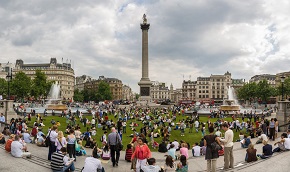Space
In very general terms, ‘space’ is an abstract term which tends to refer to a location which has not had a specific human value or purpose attached to it. This is as opposed to a ‘place’ which has an identifiable character, or a ‘location’ which has geometrical certainty.
Designers sometimes refer to 'negative space' as the space between and around objects such as buildings.
A public space is an area that tends to be open and accessible to all people. This includes roads, pavements, town squares, parks, beaches, and to a more limited extent public buildings such as town halls and libraries. The term 'common land' is sometimes used to refer to land in public ownership or to which everyone has access. To have such status, land must be legally registered as a common.
Privately-owned 'public' spaces are also a common feature of urban developments.These are spaces that are open to the public but owned and maintained by a private company. In some cases, this has been criticised for removing space from the public realm, with owners sometimes applying more rules and restrictions than there would otherwise be. Those in favour however argue that, in many cases, it can involve the improvement and regeneration of spaces that were previously neglected or poorly-used.
Space can also refer to a specific area or volume within a building, such as; useable and un-useable space, storage space, teaching space, and so on.
There are a number of guidelines, standards and regulations for the sizes of specific spaces. For example, in 2015, the government published the Technical housing standards - nationally described space standard which replaced existing space standards used by local authorities. This standard deals with internal space within new dwellings and sets out requirements for the gross internal floor area of new dwellings at a defined level of occupancy as well as floor areas and dimensions for key parts of homes.
For more information see: Technical housing standards - nationally described space standard.
Other articles relating to space on Designing Buildings Wiki include:
- Accessibility in the built environment.
- Bedroom standard.
- Bedspace.
- Building spaces.
- Conservation areas and protecting open space.
- Local green space.
- Minimum bedroom size proposals.
- Minimum space standards.
- NHBC technical standards.
- Placemaking.
- Public space intervention.
- Office space planning.
- Open space definition.
- Space classifications for lighting controls.
- Space planning.
- Terraced houses and the public realm.
[edit] Related articles on Designing Buildings Wiki
Featured articles and news
Infrastructure that connect the physical and digital domains.
Harnessing robotics and AI in challenging environments
The key to nuclear decommissioning and fusion engineering.
BSRIA announces Lisa Ashworth as new CEO
Tasked with furthering BSRIA’s impressive growth ambitions.
Public buildings get half a million energy efficiency boost
£557 million to switch to cleaner heating and save on energy.
CIOB launches pre-election manifesto
Outlining potential future policies for the next government.
Grenfell Tower Inquiry announcement
Phase 2 hearings come to a close and the final report due in September.
Progress from Parts L, F and O: A whitepaper, one year on.
A replicated study to understand the opinion of practitioners.
ECA announces new president 2024
Electrical engineer and business leader Stuart Smith.
A distinct type of countryside that should be celebrated.
Should Part O be extended to existing buildings?
EAC brands heatwave adaptation a missed opportunity.
Definition of Statutory in workplace and facilities management
Established by IWFM, BESA, CIBSE and BSRIA.
Tackling the transition from traditional heating systems
59% lack the necessary information and confidence to switch.
The general election and the construction industry
As PM, Rishi Sunak announces July 4 date for an election.
Eco apprenticeships continue help grow green workforce
A year after being recognised at the King's coronation.
Permitted development rights for agricultural buildings
The changes coming into effect as of May 21, 2024.






















